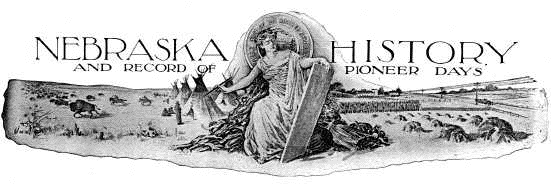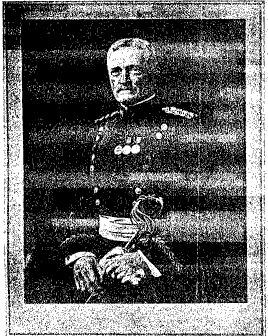
|
2 |
|
|
HISTORICAL SKETCH Upon
the 26th day of August. 1867, twenty-eight days after the
city of Lincoln was located, a plat of the proposed capital
of Nebraska was filed by Commissioners Butler, Kennard and
Gillespie and Surveyors Smith and Harvey. Upon this plat
block 29, lying it the southwest corner of the State
University campus was designated "State Historical and
Library Association Block." On this same day articles of
incorporation of the State Historical and Library
Association were filed in the office of the county clerk of
Lancaster county. It was the idea of the founders of the new
capital city, as sworn to by them in court at a later date,
to establish an institution, in connection with the State
University, for permanent preservation of the state's
history throughout all future time. The annals of Nebraska since the first white settlement show that her people have had part in the following military conflicts: 1823
- The
Arikara Indian war. Some of these, like the Pawnee war of 1859 or the Mexican war |
so far as relates to Nebraska, may seem too much dignified by their assignment to a place in this list. But each one in the list involved the marching of military across Nebraska soil and some of them fierce conflicts within our boarders. A series of historical sketches on Nebraska's part in these wars will appear in this journal. HISTORICAL SOCIETY BOARD - NEW MEMBERS Seventeen members constitute the board of the Nebraska State Historical Society. Like the British constitution this board is the growth of years and of different ideas. Three distinct groups appear in its composition, first, ex officio members holding state offices; second, officers of the Society elected annually; third, trustees elected for three- year terms. Three vacancies among these trustees were filled at the annual election, January 16. The retiring members were Bishop Tihen, who had been transferred to Denver, Mr. Gurden W. Wattles of Omaha, food administrator of Nebraska, who asked to be relieved because of his heavy duties in that position, and Mr. George .W. Hanson of Fairbury, absent in California. For these places there were chosen Rev. Michael A. Shine of Plattsmouth, one of the most active and scholarly writers in the field of Nebraska history; John F. Cordeal of McCook, senator in the legislatures of 1911 and 1913, an able lawyer and special investigator and writer upon the history of southwestern Nebraska; and N. P. Dodge Jr., of Omaha, senator in the legislatures of 1913 and 1915, champion of Nebraska's child labor law and other important progressive legislation and member of a family whose name has been associated with the history of Nebraska and Iowa from the earliest days. It is the desire of those directing the work of the Historical Society to bring upon its board men and women with a deep personal interest in the history of the state. The three new members belong to this Class and each has contributed toward the making and recording of its great events. The officers and board of directors for the year 1918 are as follows: Keith
Neville, governor, Novia
Z. Snell, Lincoln. President,
Samuel C. Bassett, Gibbon. THE NEBRASKA PRESS AND THE HISTORICAL SOCIETY In Kansas the State Historical Society was founded by he State Press Association. In Nebraska the founding of the Society was initiated by the editor of the Brownville Advertiser and conspicuous among its early officers are the names of such noted editors as J. Sterling Morton, of the Nebraska City News. George L. Miller of the Omaha Herald, and Charles H. Gere of the Nebraska State Journal. Editors are the natural historians of their times. The best general view of any decade in Nebraska history is found by reading the columns of the newspapers then published. One of the best services the Historical Society can render to the people of Nebraska is the careful preservation of newspaper files. Upon the exchange list of the Society at present are 553 Nebraska newspapers, including nearly all the dailies and weeklies published in the state. In our library are over 10,000 bound volumes of the Nebraska press. Among these are such priceless files as those of the Nebraska Palladium, Brownville Advertiser, Nebraska City News, Omaha Arrow, Omaha Nebraskian, Omaha Herald, Falls City Broadaxe and Dakota City Herald covering the period from 1854 to 1870. For the period following 1870 we have such notable files as The Grand Island Independent, Columbus Journal, Wilber Opposition, Milford Blue Valley Record, Omaha Republican, Omaha Bee, and others. The systematic collection of Nebraska newspapers for the Historical Society was began by Professor Howard W. Caldwell in 1891. Since that time we have fairly complete files of some hundreds of Nebraska newspapers. The files previous to that time have been gathered by individual effort and most of them during the past fifteen years. Every year emphasizes the importance of this work. Many of the most valuable Nebraska newspaper files have been destroyed by fire. We have continual inquiries now for copies of legal notices and important public events found in tire Historical Society files and nowhere else. The present secretary served fourteen years as compositor, reporter and editor in Nebraska newspaper offices; Mr. Albert Watkins, historian, was for many years editor of the Mineral Point (Wis.) Democrat, the Sioux City Tribune and later of the Daily State Democrat of Lincoln. Every editor in Nebraska is placed upon the exchange list of "Nebraska History." He is asked in exchange for the publications of this society to send duplicate copies of his own paper, one copy for the permanent bound files of the Society and the other for historical clippings, which will be mounted and arranged under convenient topics. Every editor is cordially invited to clip from the Historical Society publications and to make himself a special agent for his locality in securing for preservation important historical records and relics. |
|
|
3 |
General John H. Pershing
Commander of the American Armies in Europe

|
General Pershing was commandant of the cadet battalion at the University of Nebraska in the years 1891-95. He graduated from the University of Nebraska, college of law, in 1993. A high degree of enthusiasm and efficiency marked the military department of the University during the years he was at its head. The "Pershing Rifles," an honorary organization open to students having the best records in military training, was instituted in his honor and has continued since he was commandant. General Pershing was born in Linn county, Missouri, September 13, 1860, and graduated from West Point in 1886. His military career includes service against the Apache Indians in Arizona, 1886, and in the Sioux War. 1890-1; in the Santiago campaign, Cuba. 1898; in the Philippines 1899-1903; as military observer |
with the Japanese army in Manchuria 1905; commander department of Mindanao in the Philippines from 1906 to 1913 and of U. S. troops in Mexico, 1916. General Pershing married the daughter of Senator Warren of Wyoming, January 26, 1905. His wife and three daughters perished in the burning of Presidio barracks, August 27, 1915. His sisters, Mrs. David M. Butler and Miss May Pershing. live at 1748 B street, Lincoln. His only son. Warren, seven years old, lives with them. The name Pershing was originally spelled Pfirsching. The family came from Alsace-Lorraine to America about a century ago. General Pershing is therefore fighting on the borders of his ancestral fatherland for America and the world in the present war. |
|
In
response to many inquiries regarding books on Nebraska
history the following has been prepared. |
state histories published by private enterprise and a much larger number of county and municipal histories from the same sources: also some historical pamphlets of value. Most of these may be found in the Society library. Publications of the Nebraska State Historical Society. Transactions
and Reports of the Nebraska State Historical Society Vol. 1,
1885, 8 vo. clo., 233 pp., $1.25; paper in 4 pts., $0.75.
Editor Robert W. Furnas. |
|
4 |
|
|
Sixteen
miles north of Omaha, at the present village of Fort
Calhoun, on the site of the Council Bluff where Lewis and
Clark first held council with the Indians in 1804, once
stood Fort Atkinson, located in the year 1819, the first
United States fort in Nebraska. On
board the Keel Boat. rocky Dear sir: Your
friend and Obt servt Following
are parts of four orders issued by Colonel Leavenworth at
"Head Quarters 6th Infantry Fort Atkinson" June 18, 1823 |
sible to march at a moment's warning. . . The actg post Qr. Mr. will immediately engage the Keel Boat and her patron and as many of the efficient men with her as practicable. Officers Commanding Companies ordered to be ready to march will have their Companies completely equipped and ready for inspection at four o'clock this afternoon when they will be paraded for that purpose. It is indispensably necessary that every possible exertion should, be made to keep the men clean and to preserve their Soldierly appearance. . . . The boats going up the river will be designated as No. 1, No. 2. and No. 3. . . . The companies will take as many of their spades & axes as are fit for use... H. Leavenworth, Col. Comdg. The
command, comprising about 220 men, arrived before the
Arikara villages on the 9th of August, having made the
distance from Council Bluffs. 640 miles, in forty- eight
days. It had been joined by Major Joshua Pitcher of the
Missouri Fur Company with forty men, General William H.
Ashley's force of about the same number, and some 500 Sioux,
making it total force of about eight hundred men. Opposed to
them there were about six hundred warriors in the two
Arikara villages, and between three and four thousand
individuals all told, - men, women and children. Aug. 29, 1823. The
Colo. Comdg. is happy to announce to his Command that the
objects of the late expedition against the Aricara Indians
have been effected. The blood of our Countrymen has been
honorably avenged H.
Leavenworth, |
Vol I
Return to NE History & Record of Pioneer Days
© 1998, 1999, 2000, 2001 for NEGenWeb Project by Ted & Carole Miller